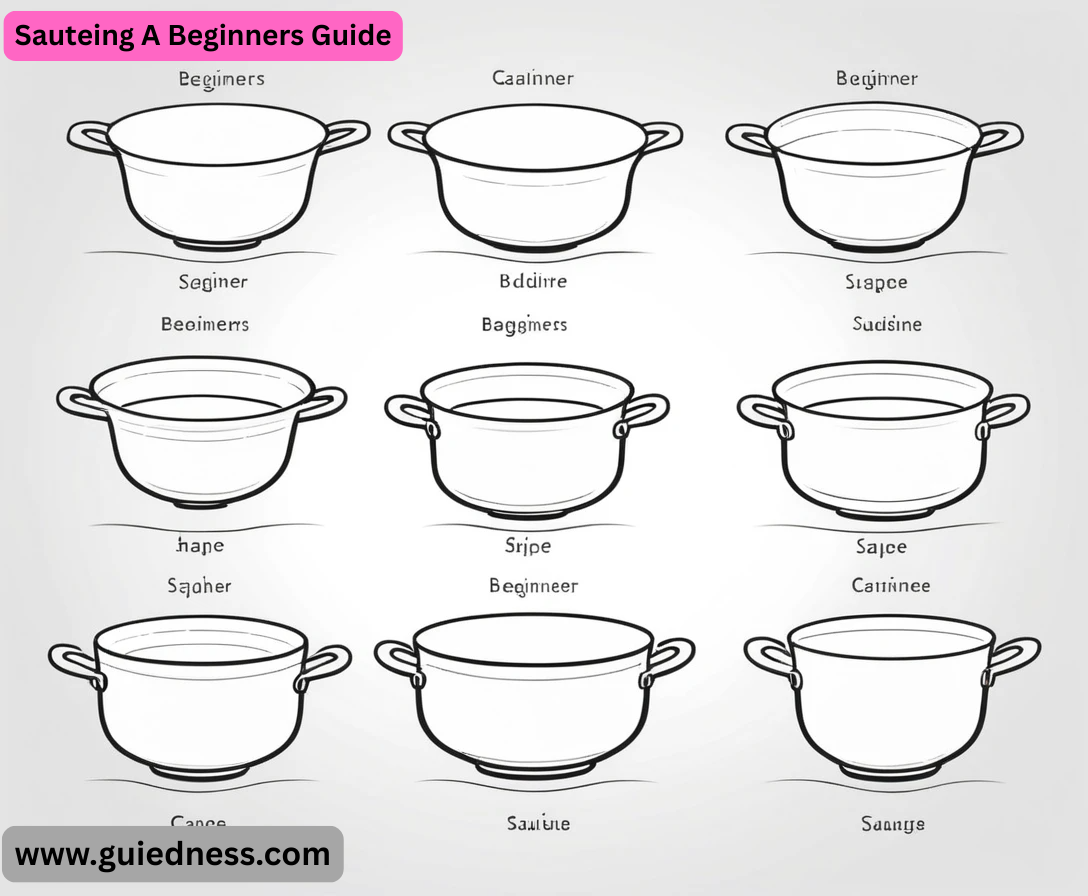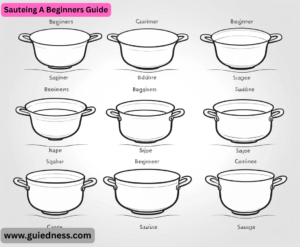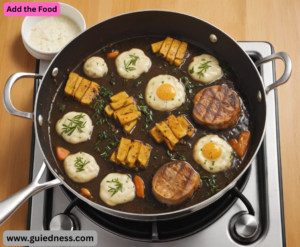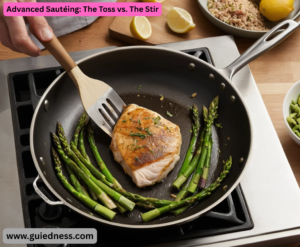Sauteing A Beginners Guide Of course! Here is a comprehensive beginner’s guide to sautéing, designed to take you from nervous novice to confident cook.
What is Sautéing?
- The word “sauté” comes from the French verb sauter, meaning “to jump.” It’s a cooking method that uses a small amount of fat in a shallow pan over relatively high heat. The goal is to cook food quickly, creating a beautifully browned, flavorful crust while keeping the interior tender. It’s perfect for vegetables, thinly sliced meats, chicken, and seafood.
The Golden Rule: Mise en Place
- This is the most important step for successful sautéing. It’s a French term that means “everything in its place.”
- Why? Because the process is fast! You won’t have time to chop garlic or measure spices while your food is burning.
How to do it:
- Chop/Cut: Prepare all your ingredients and cut them into uniform sizes so they cook evenly.
- Measure: Have your oils, butter, wine, spices, and herbs ready to go.
- Organize: Place everything within arm’s reach of the stove.
The Essential Equipment
The Pan: A Skillet (The Workhorse)
- Sauteing A Beginners Guide Best Choice: Stainless Steel or Carbon Steel. They provide the best browning (called the Maillard reaction) and can handle high heat. They are also oven-safe.
- Great Alternative: A Good Non-Stick Skillet. Perfect for delicate foods like fish or eggs and requires less fat. It’s very forgiving for beginners. Avoid high heat with non-stick, as it can damage the coating.
- Size Matters: A 10-inch or 12-inch skillet is the most versatile for 2-4 servings.
- Avoid: Deep pots with straight sides. They trap steam and won’t give you that crispy sear.
The Utensil: A Spatula or Tongs
- You need something to flip, toss, or stir the food. A thin, flexible metal spatula is great for getting under food. Tongs are excellent for turning pieces of meat or chicken.
The Fat: Your Cooking Medium
- High Smoke Point Oils: Use these for high-heat sautéing. Avocado oil, grapeseed oil, canola oil,
- For Flavor: Extra virgin olive oil is fine for medium-heat sautéing (like onions and garlic). Butter adds incredible flavor but burns easily. For a solution, see the pro tip below.
The Step-by-Step Sauté Method
- Let’s use the example of sautéing chicken breast with zucchini and peppers.
Step 1: Heat the Pan
- Place your dry skillet on the stove over medium-high to high heat. Let it get hot for a minute or two. A properly heated pan is crucial for preventing food from sticking and for achieving a good sear.
Step 2: Add the Fat
- Add your oil (e.g., avocado oil) and swirl it around the pan to coat the bottom. It should shimmer almost immediately. If it smokes, your pan is too hot. If it just sits there, your pan isn’t hot enough.
Add the Food
- Don’t Crowd the Pan! This is Rule #2. If you add too much food, the temperature plummets, and the food will steam instead of sauté, becoming soggy and pale. Cook in batches if necessary.
- Place your food in the pan in a single layer, leaving a little space between each piece.
Listen for the sizzle! That’s the sound of success.
Step 4: The “Don’t Touch” Rule
- Sauteing A Beginners Guide Resist the urge to constantly stir or flip! Let the food sit undisturbed for a few minutes to develop that golden-brown crust. You can shake the pan gently to make sure nothing is sticking.
Step 5: Flip or Stir
- Once the food is browned on one side, flip or stir to cook the other side. For vegetables, you can stir more frequently to cook them evenly.
Step 6: Aromatics & Seasoning
- If your recipe calls for garlic, ginger, or fresh herbs, add them towards the end (in the last 1-2 minutes). They burn very quickly and will become bitter if added too early. Season with salt and pepper as you cook.
Step 7: Deglazing (The Pro Move)
- After removing the food, you’ll often see browned bits stuck to the pan. That’s pure flavor! Turn off the heat, add a small amount of liquid like wine, broth, or lemon juice, and use your spatula to scrape those bits up. This creates an instant, delicious pan sauce to pour over your food.
Beginner Recipe: Simple Sautéed Garlic & Herb Mushrooms
This is a perfect practice recipe.
Ingredients:
- 8 oz cremini or white mushrooms, cleaned and halved
1 tbsp olive oil
- 2 cloves garlic, minced1 tbsp fresh thyme (or 1 tsp dried)
Salt and pepper to taste
- 1 tbsp butter (optional, for finishing)
- 1 tbsp fresh parsley, chopped (for garnish)
Instructions:
- Mise en Place: Halve the mushrooms, mince the garlic, and chop the herbs.
- Heat a large skillet over medium-high heat.
- Add the olive oil and swirl to coat the pan.
- Add the mushrooms in a single layer. Don’t stir for 2-3 minutes! Let them get brown on one side.
- Stir and continue cooking until they are browned all over and have released their water, about 5-7 minutes total.
- Reduce heat to medium. Add the minced garlic and thyme. Cook for just 30-60 seconds, until fragrant.
Season generously with salt and pepper.
- Remove from heat. Stir in the butter (if using) until it melts and coats the mushrooms.
- Garnish with fresh parsley and serve immediately.
Pro Tips & Common Mistakes to Avoid
- Sauteing A Beginners Guide Dry Your Food: Pat meats, seafood, and even washed vegetables very dry with a paper towel. Moisture is the enemy of browning; it will steam the food instead.
- Butter Burn Solution: Use a mix of oil and butter. The oil raises the smoke point of the butter, allowing you to get the flavor without the burn.
- The Pan is Too Cold: If your food immediately soaks up the oil and sticks, the pan wasn’t hot enough.
- The Pan is Too Crowded: Remember, steam is the enemy of sautéing. Give your ingredients space!
- Constantly Stirring: Let the food sit to develop a crust. Trust the process.
Advanced Sautéing: The Toss vs. The Stir
There are two primary ways to move food in a sauté pan:
- The Stir: Using a spatula or spoon to move the food around. This is straightforward and great for beginners, or for dishes where you want more consistent browning on all sides (like cubes of chicken or potatoes).
- The Toss: The classic chef’s move. This involves jerking the pan towards you in a quick, sharp motion, causing the food to flip over itself. It’s not just for show—it’s highly effective.
- Why Toss? It allows you to efficiently turn many pieces of food at once without crushing them (delicate fish fillets, asparagus) and without using a utensil that can scratch a non-stick pan.
- How to Practice: Start with a cold pan and some dried beans. Practice the motion: a quick, confident flick of the wrist and a slight pull towards you. The goal is to make the beans jump and flip, not fly out of the pan.
The Fat Directory: Choosing Your Cooking Oil
- The fat you choose is critical as it adds flavor and prevents sticking. Its smoke point—the temperature at which it starts to burn and smoke—is the key factor.
Ingredient-Specific Guides
1. Vegetables
Dense Vegetables (Potatoes, Carrots, Broccoli): Often benefit from blanching (a quick boil) before sautéing to ensure they cook through without burning.
- High-Water Vegetables (Zucchini, Mushrooms, Onions): Can be sautéed directly. Salt them during cooking to help draw out moisture and encourage browning.
- Leafy Greens (Spinach, Kale): Add to the hot pan with just the water clinging to their leaves from washing. Toss constantly—they will wilt in seconds. For kale, remove the tough stems first.
- Aromatics (Garlic, Ginger, Shallots): ALWAYS add them towards the end (last 30-90 seconds). They burn in an instant and will turn bitter.
2. Proteins
- Sauteing A Beginners Guide Chicken Breast/Thighs: Pound to an even thickness for uniform cooking. Pat extremely dry. Season right before going into the hot pan to prevent moisture loss.
- Fish Fillets: Pat dry. Season. For skin-on fish, start skin-side down in the hot oil. Press gently with a spatula for the first 30 seconds to prevent curling. Don’t move it until the skin is crispy and releases easily from the pan.
- Shrimp: Pat dry. They cook very quickly (2-3 minutes per side). They are done when they form a tight “C” shape. An “O” shape means they are overcooked.
- Thinly Sliced Beef/Steak Strips (for stir-fry/Philly cheesesteak): Pat dry. Work in very small batches to avoid crowding. Sear for just 30-60 seconds per side for medium-rare.
Building a Pan Sauce: The Ultimate Finishing Move
- This is where you turn the browned bits left in the pan (the fond) into a luxurious sauce in minutes.
- The Formula:
- Cook your protein (e.g., a chicken breast). Remove it to a plate to rest.
- Aromatics: In the same pan, with the heat on medium, add a small diced shallot or a bit more garlic. Cook for 1 minute until fragrant.
- Deglaze: Add ~1/2 cup of liquid. Wine, broth, vermouth, or even lemon juice work. Use a whisk or spatula to scrape all the browned bits off the bottom of the pan.
- Enrich: Turn off the heat. Add a few cold pats of butter and swirl the pan until it melts and thickens the sauce slightly. This is called monter au beurre.
- Finish: Stir in any fresh herbs (parsley, tarragon, chives). Taste and season with salt and pepper. Pour the sauce directly over your rested protein.
- Example Pan Sauce: After cooking a pork chop, add minced shallot → deglaze with apple cider → swirl in butter and fresh sage.



